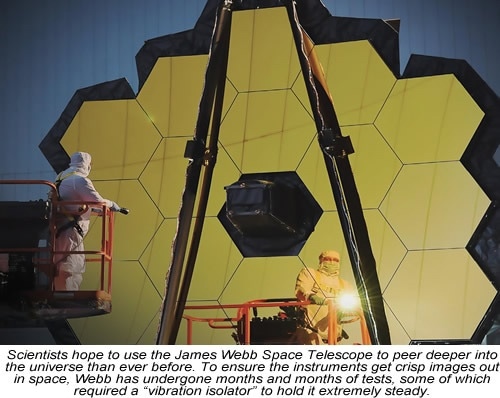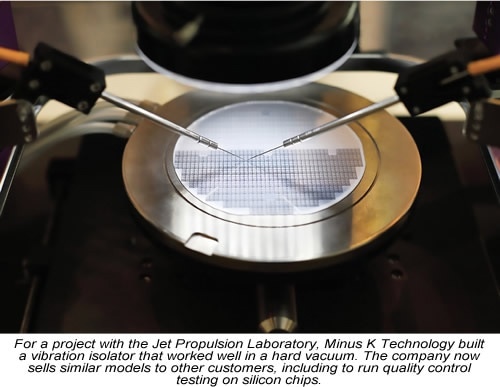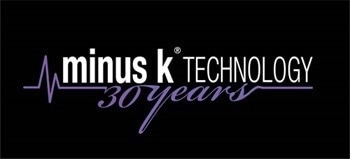If anyone has ever attempted to hold a camera steady and exposed to low light for a long time, they would exactly what inevitably happens: the camera shakes, and the image becomes blurred. This is the same in the case of images from telescopes or any other long-range image. Actually, for some extremely sensitive optics, even normal ground vibrations can be enough to affect the results.
Serge Dubovitsky, instrument system engineer at the Jet Propulsion Laboratory (JPL), states that this is why NASA often requires a tool known as a vibration isolator. This functions in a few different ways but typically offers a more stable platform where there is no interference of external vibrations with sensitive measurements.

Dubovitsky usually works on optics, such as systems of mirrors for observational missions — for example, telescopes. Light is reflected by the mirrors in various wavelengths, focusing it into an image that can be examined using other instruments. However, before these optics can be set up, it is necessary to test them to make sure they work as planned.
For optics that operate in roughly visible wavelengths, any motion on the scale of one micron [that is, one-millionth of a meter], or in some cases even much less than that, disturbs the image quality.
Serge Dubovitsky, Instrument System Engineer, Jet Propulsion Laboratory
Furthermore, optics testing is usually done in a vacuum, with outcomes for vibration isolators. “Vacuum is important in verifying optics because air interferes with light. If you are aiming at space applications, on the ground you need vacuum,” Dubovitsky reports. A vacuum can be helpful for testing even when operating with optics that will stay on the ground.
However, vacuum poses its own problems, particularly for vibration isolators, which usually use air to make the platform “float” and are likely to include bladders and hoses made with rubber, which can leak or outgas, discharging lightweight molecules that could interfere with the vacuum. Moreover, air systems must have the ability to vent exhaust gases without affecting the vacuum. For other systems that use electricity, there is a possibility of overheating as there is no airflow to help disperse the heat.
JPL was given a recent project that needed an isolator to test space-ready optics, which needs quite a high degree of vacuum in comparison with typical industry standards; therefore, they sought the help of a company known as Minus K Technology.
Technology Transfer
NASA has purchased a number of vibration isolators from Minus K for years — including a system for the James Webb Space Telescope of six isolators, uniquely developed to hold up to 10,000 pounds each. This capacity is much larger than what Minus K had ever developed in the past, and the company assumes that this is the largest-capacity vibration isolator in the world for this kind of application.

Six of our isolators are now on top of a chamber at Johnson Space Center supporting that project. Now that we have the design, we could adapt it for other customers too.
Erik Runge, Engineering Director, Jet Propulsion Laboratory
Runge says that customers have already shown interest.
According to Runge, although Minus K has a lot of experience in constructing vibration isolators for vacuum, the JPL project needed further innovation. “Even if you have someone that needs a vacuum system,” he notes, “there are different levels of vacuum. Some have a very slight vacuum, some have a very hard vacuum. There are different requirements for materials that can be used, types of coatings that are OK, and so on. We learned about what special requirements were needed at high vacuum levels.”
Among other modifications, he explains, the company had to test special greases and parts to determine what would work best in a hard vacuum and not leak. “As a result of some of the things we’ve learned, we can make all of our vacuum-compatible isolators to work at a higher level of vacuum, when needed,” stated Runge.
Benefits
Isolators from Minus K are developed differently when compared to many other devices and this is one of the reasons why isolators from Minus K work so well in vacuums, Runge states. “Our isolators use no air and no electricity. They are happy as can be in a vacuum.”
The isolators operate via negative stiffness mechanisms, typically affixing the platform on a system of flexures or springs, “loaded in such a way that we can control the net stiffness of an entire system,” says Runge. “If you can control the stiffness, you have direct control of the resonant frequency of the system, and the resonant frequency of the system is what determines the isolation performance.”
In order to envision how this functions, he states, assume a rubber band expanded with a heavy weight attached. If the rubber band is moved up and down slowly, the weight will also move at nearly the same rate as the hand; move it precisely at the accurate speed, and the resonant frequency can be achieved, where a small input amplifies in a recurring cycle. However, if the rubber band is moved faster than that, the weight will remain constant. “You’re going to see your hand moving, but the weight won’t move,” stated Runge.
Isolators from Minus K can maintain vertical isolation with those flexures and springs, and they attain isolation horizontally through a set of columns.
You can kind of think of them as inverted pendulumns. The more mass you put on them, the lower the resonant frequency will be until at some point there’s too much weight and they won’t be able to restore themselves. By keeping the weight close to that upper limit, we can adjust the resonant frequency horizontally.
Erik Runge, Engineering Director, Jet Propulsion Laboratory
According to him, although Minus K isolators are employed to stabilize optical microscopes, electron microscopes, and other scientific instruments, the vacuum-compatible isolators are also used to facilitate quality control in manufacturing semiconductors. “When building chips and measuring chips, they need to have as close to no vibration as possible,” he says.
He added that other companies have purchased the vacuum-compatible isolators for optics, and yet others have not mentioned the final application, in part because most of the applications are associated with defense work. “Vacuum chambers large enough for an isolator tend to be pretty expensive,” he notes, which implies “not many people have them.”
However for clients like NASA, the Department of Defense, and the National Laboratories, vacuum-compatible isolators from Minus K are an excellent tool, says Dubovitsky, and he hopes that NASA will continue to deal with Minus K for future projects as well. “They have a unique product that provides very clean isolation.”

This information has been sourced, reviewed and adapted from materials provided by Minus K Technology.
For more information on this source, please visit Minus K Technology.